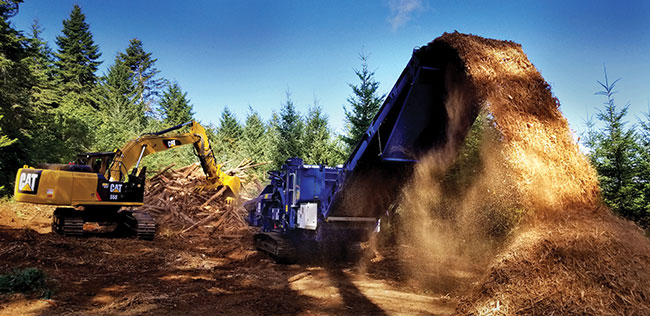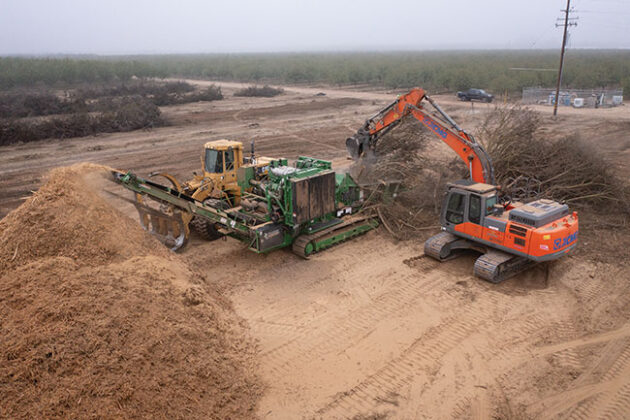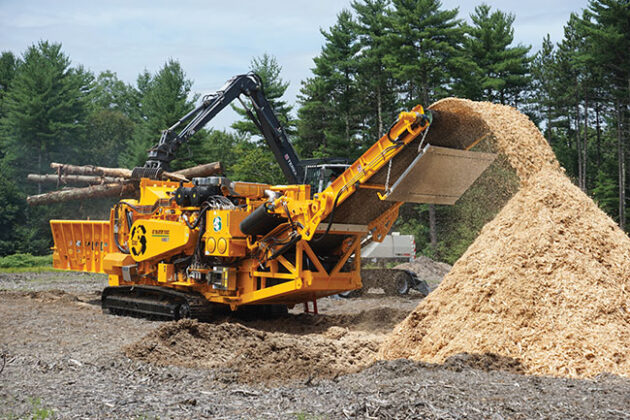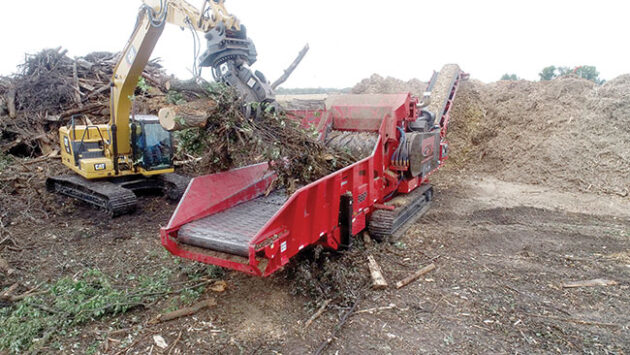
Chipper versus grinder: Depends on the application
February 14, 2023
By
Andrew Snook
Advice from chipper and grinder suppliers on choosing the right machine for your woody biomass harvesting needs.
 If feedstock is contaminated, a grinder is a preferable option designed to tackle abrasive material. Photo courtesy Astec Industries.
If feedstock is contaminated, a grinder is a preferable option designed to tackle abrasive material. Photo courtesy Astec Industries. Chippers and grinders both have their places in the world of woody biomass processing. When deciding between a chipper or a grinder for woody biomass operations, knowing the type of products you need to produce for your customers is key.
“What’s your customer buying? What’s the end product that you’re making? What are they looking for?” asks Michael Spreadbury, product manager for forestry and recycling equipment at Astec Industries.
If the customer is looking to purchase an engineered chip with very particular specifications, a drum chipper is likely to be the more appropriate choice.
“If it’s a logging or land clearing operation that wants to process whole trees at a fast rate, and produce a quality dimensional chip, then a whole tree chipper is normally the preferred option,” explains Jason Morey, marketing manager for Bandit Industries.
“CBI drum chippers are more suited for the production of fuel products made from woody biomass while our disc chippers are more often used in pulp and paper,” adds Jonathan Gilmour, regional sales manager for CBI, a Terex brand. “We recommend a chipper when processing virgin materials only. They are not fitted for wood recycling or processing contaminated feeds. Chippers tend to be more application specific.”
An advantage of operating a drum chipper is that is very fast and efficient at making a consistently sized end product.
“The biggest advantage of a chipper is efficiency. They are extremely efficient in taking virgin woody biomass and turning it into a saleable chip product. So, if that’s your sole business, and that’s all you’re ever going to do, a chipper is a sensible solution,” Gilmour says.
But to get that efficiency, having the right feedstock is key. Drum chippers work much more efficiently with clean wood.
“As we say: garbage in, garbage out,” Spreadbury says. “If you’re trying to do tops, logging residuals or really odd-sized pieces, you’re going to have a very hard time making a really nice consistent product with a drum chipper.”
“Wood contaminated with dirt or rocks will dull chipper knives,” adds Jamey Brick, COO for Rotochopper. “If the wood has been skidded, it has picked up enough dirt to quickly dull knives. Also, material like slasher debris doesn’t feed into a chipper very evenly because it contains smaller pieces that the feed system cannot control. Dull knives make the problem even worse because they will pull the wood inward instead of cutting it cleanly.”
Embracing the grind
If the feedstock is dirty, a grinder may be the better option.
“For contaminated wood, a grinder can use hardfaced teeth designed for abrasive materials. A chipper can rapidly lose efficiency as knives lose their edges, but a grinder is designed to operate with blunt teeth. So grit and gravel doesn’t affect the grinder as much as it does a chipper,” Brick says. “A chipper works best with straight logs versus logs with lots of branches and limbs. Grinders tend to handle irregular pieces more efficiently.”

Chippers tend to be more application specific, ideal for fast whole-tree processing. Photo courtesy Bandit Industries.
Grinders are good choices for producing woody biomass where the customer specifications have more room to vary.
“If they’re just looking for more of a boiler fuel, they don’t care as much about the size specs that they’re looking for. A grinder would be a better choice,” Spreadbury says. “A grinder is much more diverse. You can put all kinds of different things in there. And by changing the tooling, you can radically change the end product that you’re getting out of the machine.”
For producing residential wood pellets, the feedstock needs to be relatively clean, and a chipper is likely the better option for processing the wood due to its ability process clean feedstock quickly.
“If you’re going into industrial pellets that can be a little dirtier, so you can get into some grinder type applications,” Brick says.
That said, there are biomass-fuelled power plants that require clean wood chips and microchips for specific specifications. If you’re burning wood chips in a power plant that was converted from coal, wood chips have a tendency to flow better in the feeding bins than grindings.
“With a lot of your traditional coal-powered plants, the angles of the hoppers are designed for coal, so when you start throwing wood waste in it, chips often flow better than the shredded texture from a wood grinder. The ground material has a higher tendency to bridge up, where chips are generally more of a defined length – no frayed edges on them – so they flow better through conventional power plants than a ground wood product,” Brick explains.
He adds that with power plants set up to use “true biomass” it’s generally not as big of a deal to use dirtier feedstock. One big advantage with these plants is that you can get a broader source of feedstock from grinders.
“The tops of the trees have no value for making wood or paper, so you generally leave them behind, but they don’t feed into a chipper very well. With a grinder however, the feed system allows them to feed through just fine,” Brick says. “In a modern forest that’s been planted and is set up to harvest on cycles, you don’t necessarily want all this logging slash left behind. Burning it out in the woods isn’t a good option. So, with a grinder, you can process it for use in biomass plants that are designed to handle this type of material.”
This is also true for other types of power generation, like district energy systems, for example.
“It really comes down to the end product. If a biomass system features bins with the right slopes and conveyor belts and augers that aren’t too narrow, down sized material from a grinder works very well. That means a waste material can be turned into energy or heat,” Brick says.
Another advantage of having a grinder is its ability to be used in a diverse number of markets.
“A grinder is a much more versatile piece of equipment,” Gilmour adds. “Let’s say a customer’s business diversifies, they will have the ability to utilize that machine in a wider spectrum and range of material types. We have had operators purchase a grinder for woody biomass and later use the same machine to process C&D right through to wind turbine blades. Several manufacturers offer machines that can be reconfigured from grinding to chipping applications or vice versa.”
Know your fleet
When deciding on a chipper or grinder to purchase, Brick says reviewing your existing fleet is also important.

A review of your existing fleet is an important factor in a purchase decision. Photo courtesy CBI.
“A blower discharge is a defining feature of a typical chipper, which allows covered trailers to be filled from the back end. So, if the rest of your business is already set up around chip vans, a grinder may involve additional changes to your operation. A grinder typical features a conveyor discharge, which loads trailers from the side. This is something that you would need to plan for.”
Brick adds that factoring in the landings is also important.
“Where are you located, and what sized equipment can you get in your landings? Grinders, traditionally, are long compared to chippers and some of the landings aren’t big enough to support that. Chippers are a little bit more compact. Where a grinders conveyor could add 20 feet or more onto the machine’s footprint.”
Maintenance factor
Brick says that grinders, in general, have fewer maintenance requirements than a chipper.
“The knives on a chipper have to be sharp. You’re going to want to start out the day with sharp knives. And in general, you’re sharpening them at noon for the second half of the day to keep them sharp and efficient. If you have clean wood, that might not apply. But if you have dirty wood, those knives are getting dull. Once they start getting dull, you’re not making that nice defined product, you’re making a stringier product with less defined length,” he says.
“No matter the machine or application, you’re always going to have to carry out daily machine maintenance,” Gilmour adds. “However, typically a chipper will require more frequent wear part upkeep such as daily knife sharpening while a grinder can run significantly longer between wear part replacement.”
The right tool for the right job
At the end of the day, both grinders and chippers have a place in the world of woody biomass applications.

Look for opportunities to demo machines before purchasing, especially if you need a specific application. Photo courtesy Rotochopper.
“No machine will be a perfect fit for every application. Both chippers and grinders have a place in our industry,” Gilmour says. “Understanding a business’ challenges and end goals will allow us to better recommend the equipment that will suit their short and long term needs.”
Morey says his advice to companies looking into sourcing a chipper or a grinder is to do their homework reviewing the available options before purchasing anything.
“Definitely do your research and determine which manufacturers machines will work best for your operation. Ensuring there is adequate support in your area is also very important. Bandit has a variety of videos on our website outlining each machine, and a high quality dealer network across North America. So, no matter where you are located, we can usually service that area,” he says.
Morey also recommends requesting opportunities to demo the machines.
“If it comes down to a couple of manufacturers that they may be interested in, reach out to the companies or the dealers to say, ‘Hey, we are interested in going this direction. Can we try it out?’ Normally, we like to bring the machine out for a day or two, especially with a specific application we are trying to achieve. We want to work with the customer or potential buyer to make sure our machine is capable of producing that product, which we’re usually fairly certain it will. But sometimes, if it’s a special product, it might take a little longer,” he says.
“But when it comes down to a couple of manufacturers, definitely look at that opportunity to demo this equipment. It’s an expensive investment, but it does last a long time, and making sure that it performs at a high level and that produces the product they need is very important.”
Print this page